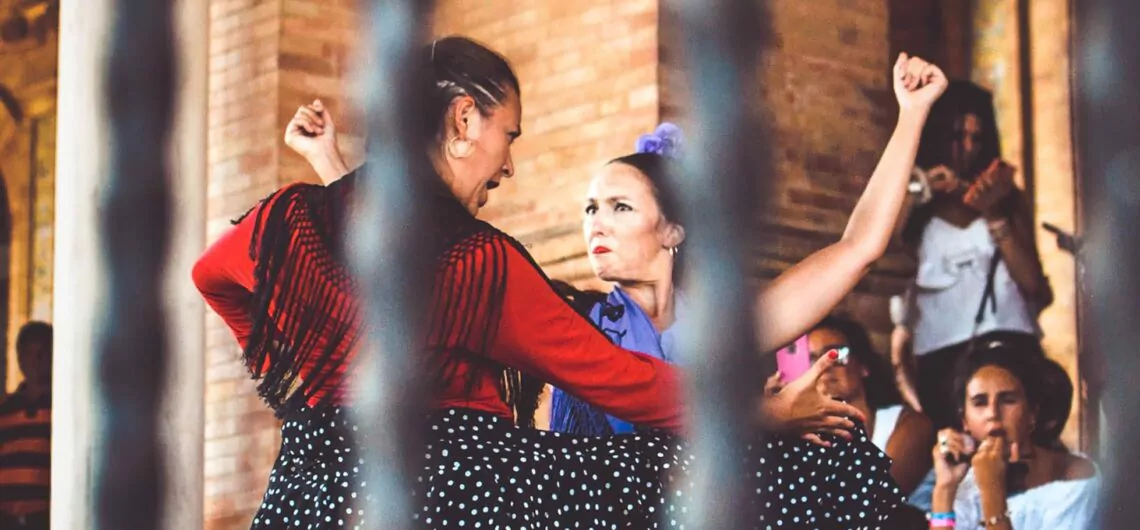It is a common misconception that Barcelona is part of the very Spanish tradition of flamenco. This is not the case. Flamenco originates from the southern region Andalucía’s contact with Arab (North-African) culture. The Catalonian folk music, on the other hand, with its root further north in Europe, could hardly be more different! This doesn’t mean that you can’t experience great flamenco music and dance shows in Barcelona.
There’s a large Andalusian community in the region. Historically, Catalonia has attracted workers to its numerous factories from all over Spain, as it has been the engine of the industrial revolution in the country. This community brought with them some of their most valued culture heritage: flamenco.
Interestingly, though, the newest (and most) sparkling star on the flamenco heavens is Catalan, Rosalía. Not being of Andalusian, or gypsy, origin and mixing the traditional with modern grooves and production, naturally there’s a debate regarding her authenticity. Be that as it may, we see her has a product of a truly creative and productive “mestizo” culture in Barcelona.
So, while visiting the city, why not get up close and personal with the flamenco? You might not be able to catch the much in-demand Rosalia in concert, but there are plenty of opportunities to experience lesser known yet brilliant artists.
Flamenco Shows in Barcelona
- Palau Dalmases Barcelona – Beautiful setting in a 17th century mansion in the Gothic Quarter. Only 50 seats, so it is intimate and atmospheric.
- 23 Robadors – Another Old Town venue, this time in the El Raval neighbourhood. Also hosts jazz, folk and other shows.
- Tablao de Carmen – A more touristy option in the Poble Espanyol, where you can combine enjoying the historic Spanish architecture of this open-air museum with a flamenco show and dinner.
- Palau del Flamenc. Located in the center of town, in the modern Eixample neighbourhood, this “palace of flamenco” is a place for larger scale shows.
Flamenco Classes in Barcelona
If you already are, or become while visiting the city, a real flamenco enthusiast, you might feel the urge to join in the “palmeras” – the hand-clapping and the stomping feet. The wiser move, then, is to join in on some flamenco classes in Barcelona. We offer private classes, from just 24 EUR per person. Learn the steps from a real pro and you will feel the confidence to join in on the exuberance of a flamenco dance.
Where to Dance Flamenco in Barcelona
So, you’ve got you moves down and your dancing shoes on – where next? There’s not a whole lot of clubs or dance-halls dedicated solely to Flamenco in Barcelona, so keep an eye out for listings (Time-out and the like) and flyers announcing nights dedicated to flamenco. One club to recommend, however, is the above mentioned 23 Robadors located in the El Raval neighbourhood of the Old City, at C/Robadors 23. Here you can dig your heels in the floor and clap your hands to the rhythms of “bulerias”, “Sevillanas” and the “fandango”.
Flamenco – A Playlist
- Paco de Lucia – The late great flamenco guitarist was no stranger to experimenting and mixing the flamenco with various musical styles, like jazz, but his personal sound and rapid fire runs were always dominant!
- Andres Segovia – First and foremost the preeminent star in the world of classical guitar in the 20th century, but as an Andalusian no stranger to the flamenco.
- Diego El Cigala – The Madrileño of gypsy origin is arguably the most famous male singer of the flamenco of our times.
- Ojos de Brujo – A multi-cultural band to come out of Barcelona. Their mix of flamenco, rock, funk etc. made them an international favourite on the independent music festival scene.
- Rosalia -From Sant Esteve Sesrovires, Catalonia. Born in 1993, Rosalia represents a new generation not afraid to take liberties with the old forms. Her two albums to date, the quiet duo album “Los Angeles” and the rowdy, electronic “El mal querer” shows her unique stylistic reach and pure talent.

